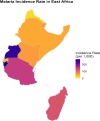The burden of malaria in East Africa: prevalence, risk factors, and control strategies
- PMID: 40781311
- PMCID: PMC12335108
- DOI: 10.1186/s12936-025-05492-6
The burden of malaria in East Africa: prevalence, risk factors, and control strategies
Abstract
Background: Malaria continues to exert a severe toll on public health in East Africa, accounting for a large share of global morbidity and mortality. Despite national strategies and donor-funded efforts, the disease persists due to complex, intersecting biological, environmental, and socioeconomic drivers. This review aims to analyse malaria burden, identify risk factors, and assess the effectiveness of control strategies across twelve East African countries to inform tailored and evidence-based interventions.
Methods: A systematic review was conducted using peer-reviewed literature, national reports, and World Health Organization surveillance data from 2015-2024. Data were synthesized from Burundi, Comoros, Djibouti, Eritrea, Ethiopia, Kenya, Madagascar, Rwanda, Somalia, South Sudan, Tanzania, and Uganda. Analysis focused on incidence, mortality, resistance trends, intervention coverage, and climate-related impacts.
Results: Uganda, South Sudan, and Burundi report the highest malaria incidence (250 + per 1000), while Eritrea and Comoros maintain the lowest. Artemisinin partial resistance has reached > 20% in multiple areas, and pyrethroid resistance in Anopheles vectors is undermining control efforts. Climate change is expanding malaria transmission into highland zones. Funding gaps persist, with only 48% of required resources secured. Nonetheless, integrated strategies involving LLINs, indoor residual spraying, vaccination, and community engagement reduce severe malaria by up to 47%.
Conclusions: To combat malaria in East Africa, urgent investments in sustainable financing, climate-adaptive interventions, resistance monitoring, and community-driven strategies are essential to avert projected excess mortality and achieve regional malaria elimination goals.
Keywords: Climate change; Control strategies; Drug resistance; East Africa; Malaria; Prevalence; Public health; RTS; Risk factors; S vaccine; Vector control.
© 2025. The Author(s).
Conflict of interest statement
Declarations. Ethics approval and consent to participate: Not applicable. Competing interests: The authors declare no competing interests.
Figures
References
-
- Nyakairu DG. The burden of malaria in east Africa: epidemiology and health impact. INOSR Appl Sci. 2024;12:20–3.
-
- ReliefWeb. Guidelines for the diagnosis and treatment of malaria in the Somali context ReliefWeb. 2023. https://reliefweb.int/report/somalia/guidelines-diagnosis-and-treatment-... Accessed 5 Apr 2025
Publication types
MeSH terms
LinkOut - more resources
Full Text Sources
Medical




